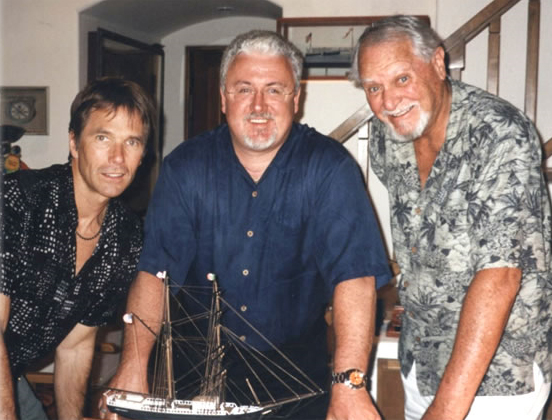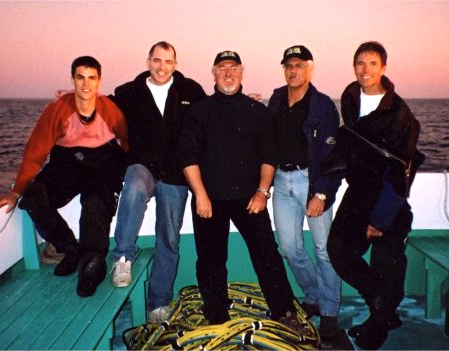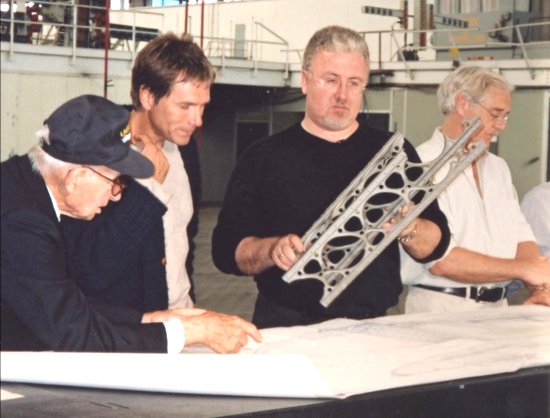Jim was privileged to work as archaeologist and host of the international TV documentary series The Sea Hunters for its full six-season run (2001-2006).
The Sea Hunters, produced by Eco Nova Productions, aired on the National Geographic and History Television Channels and was watched by over 42 million viewers in 172 countries worldwide each year.
It now plays on in reruns and in a DVD series of selected episodes.

With Clive Cussler and Mike Fletcher
Here Jim poses with fellow Sea Hunters and friends Clive Cussler and Mike Fletcher in Clive’s office in front of a model of the famous ghost ship Mary Celeste, whose burnt and broken bones the team located and identified on a Haitian reef.

Peggy’s Cove, Nova Scotia
Jim with fellow Sea Hunters Warren Fletcher, Bill Jardine (who edited several of the shows), John Davis and Mike Fletcher at the end of a long dive day off Peggy’s Cove, Nova Scotia.
Truly the grand master of adventure and shipwreck tales…
Clive’s wild tales and vivid imagination were grounded in the fact that truth is sometimes stranger than fiction. He was a detailed and careful researcher, and the tangled threads he wove made me a fan – so imagine how I felt when I was offered the chance to be on his TV show – and as the host. My favorite times were when I was able to sit down either in person or on the phone and talk wrecks with Clive. Post-series, we remained good friends, and visited each others’ homes. I also remember how we, with our spouses, took a South Pacific cruise, and met an avid group of Cussler fans on Pitcairn Island. I miss him now that he is gone, but his wit and work lives on through his many books.
Mike is one of the hardest working people I know
… and one of the best divers I have ever met – if not the best (tied with Warren of course). If the Fletchers cannot dive it, then it cannot be dived. Mike’s passion for wrecks, for history, and the show have helped make The Sea Hunters a success. Mike is not only the lead diver and underwater camera, he is directing and writing shows, the broadcasters and the public love the work he is doing. My only complaint is that he looks so darn good on camera compared to me [sigh].
He’s young, strong, good-looking
… gets all the female attention and has a full and adventurous life ahead of him. I hate Warren (just kidding, Warren!) Like Mike, Warren is an exceptional diver and he makes a real contribution to the show and for the team. I have never met anyone with his stamina or abilities in the water other than Fletcher Mod 1 (Mike), and Fletcher Mod 2 (Warren) is a unique (and I’m sure he would say an improved) version. I am always comfortable and know that things will be the best, especially underwater, when Warren and Mike are there. They’re more than teammates – they’re friends.
The poor producer always gets slagged for budgets, schedules, and just in general.
My friend, the late John Davis, was a hard working, brilliant guy with a passion for wrecks, and it was his hard work and determination that assembled our team, put it into gear, and made it work. John was a regular cast member for the first few seasons until 1) either someone at home decided he was having way too much fun, or 2) the realization that he needed to stay in the office and raise the money, ensure the broadcasters were happy, and oh, raise the money (which is always needed) came to the forefront. I miss him in the field, but I do not miss his snoring (I was often his roommate). Thanks to John, we shared the stories of amazing shipwrecks for six years. We stayed in touch for the rest of his life. I miss him.
Intrepid camera man
… dog lover, food hound, connoisseur, exceptional photographer (and cinematographer) and goodwill ambassador to the show from Newfoundland, Marc was great to work with. He always tried to film me looking as good as I possibly could (a challenge) and he added a great deal to the show. Marc’s sense of humor was tremendous and a show just wasn’t a show without him.
A multi-talented man of mystery, music, and a master of camera and sound
Johnny made us all sound good (yet another challenge) and he, well, he just sounded good. A musician of note, Johnny brought the house down on a few occasions when I was there. He was a rock on which the show was anchored – dependable, always in good humor, and with an exceptional sense of fun. I am convinced that it was John Rosborough alone who ensured that The Sea Hunters were welcome wherever we travelled.
